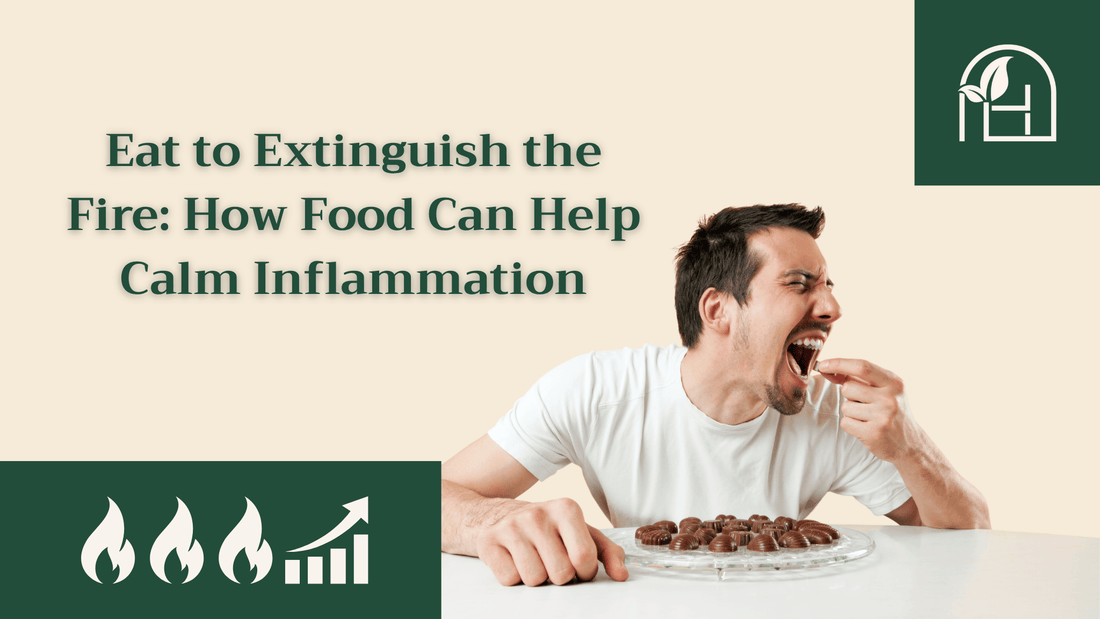
Eat to Extinguish the Fire: How Food Can Help Calm Inflammation
Ever feel like your body is a little… inflamed?
Maybe you’re not in pain exactly, but you’re bloated, tired, or breaking out more than usual. You’re not imagining things — your body might be dealing with low-grade inflammation.
The good news? Food isn’t just fuel. It’s also medicine. And with the right choices, you can help your body put out the internal fire — one bite at a time.
🥦 Anti-Inflammatory vs. Pro-Inflammatory Foods
Let’s start with what’s on your plate. Some foods cool the fire, others fan the flames. Here’s a simple guide to help you choose wisely:
| 🔥 Pro-Inflammatory Foods (Avoid or Limit) | 🧊 Anti-Inflammatory Foods (Enjoy Often) |
|---|---|
| Sugary drinks, soda, desserts | Berries, oranges, grapes (natural sweetness!) |
| Fried foods, fast food | Fatty fish (salmon, sardines) |
| White bread, pastries | Whole grains (quinoa, oats, brown rice) |
| Processed meats (sausages, deli slices) | Leafy greens (spinach, kale, bok choy) |
| Seed oils (soy, corn, sunflower in excess) | Olive oil, avocado oil |
| Excess alcohol | Green tea, water with lemon |
Quick tip: Think colorful, fresh, and close to nature — those are your “firefighters.”
💪 The Power of Omega-3s, Antioxidants, and Fiber
These three are your best friends when it comes to calming inflammation:
Omega-3s: Found in fatty fish, chia seeds, and walnuts, omega-3 fatty acids help your body balance the immune response and reduce the intensity of inflammation.
Try this: Swap one meat-based meal each week for grilled salmon with veggies.
Antioxidants: These natural compounds protect your cells from damage. You’ll find them in colorful fruits and vegetables like berries, carrots, turmeric, and leafy greens.
Try this: Add a handful of blueberries to your morning oatmeal or snack on red grapes.
Fiber: Fiber keeps your gut happy — and a healthy gut helps regulate inflammation. Whole grains, legumes, nuts, and veggies are great sources.
Try this: Replace white rice with quinoa or add beans to soups and salads.
🚫 Cut the Sugar, Ditch the Junk (Without Going Crazy)
You don’t need to become a food monk. But a few small shifts can make a big difference:
- Read labels – Look out for added sugars (hint: they’re sneaky and have many names)
- Shop the perimeter – Most real, whole foods live around the edges of the grocery store
- Batch cook whole meals – It’s easier to avoid processed foods when healthy options are ready
- Drink smarter – Swap soda for sparkling water with a slice of lime or cucumber
- Satisfy sweet cravings – Go for dark chocolate, dates, or homemade banana oat cookies
Remember, it’s not about perfection. It’s about progress.
👩 Real Story: How Lisa Reclaimed Her Energy with Food
Lisa, 42, used to feel constantly puffy, moody, and foggy. She chalked it up to “getting older.” But after watching a friend transform her health through food, she decided to try small changes.
She started with breakfast: trading sugary cereal for oatmeal with nuts and berries. Then came lunch — goodbye fried noodles, hello grain bowls with salmon and veggies.
Within weeks, her bloating eased. Her skin glowed. She even had the energy to take evening walks again.
“I didn’t go on a diet,” she says. “I just started feeding my body what it was really asking for.”
🌿 You Don’t Have to Do It All Today
You’re not alone in this. We’ve all fallen into the “convenience trap” of fast food and sugary fixes. But you can turn it around — one mindful meal at a time.
Think of your plate as a daily opportunity to care for yourself.
To calm your system.
To say, “I deserve to feel good.”
Let’s eat well and heal together. 💛
